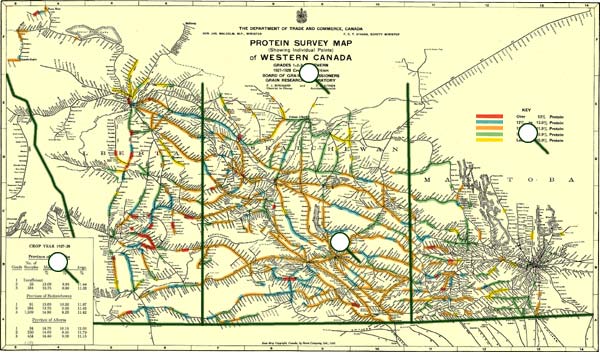Harvest Quality
1927 Protein Survey
In 1927, the Canadian Grain Commission (CGC) conducted the first Harvest Survey in Alberta, Saskatchewan and Manitoba—a large-scale protein survey of western red spring wheat. In comparison to today’s Harvest Survey, it was small, covering only one crop and one class. However, the survey reached as large an area as it does today and was the starting point for an initiative that is valued by marketers, buyers and processors of Canadian grain worldwide.
The CGC produced this map from the first Harvest Survey.
The Department of Trade and Commerce, Canada
Hon. Jas. Malcolm, M.P., Minister
F.C.T. O’Hara, Deputy Minister
Protein Survey Map (Showing Individual Points) of Western Canada
Grades 1–2–3 Northern
1927–1928 Crop Year Edition
Board of Grain Commissioners
Grain Research Laboratory
F.J. Birchard, Chemist in Charge and T.R. Aitken, Assistant Chemist
The Grain Research Laboratory (GRL) collected samples from primary elevator points located on rail lines covering the three western provinces, as indicated on the map. The survey area ranged from the Peace River area in northern Alberta, across the central and southern Prairies to points just east of Winnipeg. In 1927, 2,759 samples were collected from primary elevators.
Over the years, the CGC’s Harvest Survey has grown, including more kinds of crops and more analytical tests on quality factors. In 1995, the CGC began collecting samples from grain producers in order to increase the number and size of samples. Today, the Harvest Survey generally includes six classes of wheat, durum wheat, canola, flaxseed, solin, peas, lentils, chick peas and white beans.
In Eastern Canada, a smaller scale survey is conducted with the participation of eastern producers and the Ontario Soybean Growers, the Ontario Canola Growers’ Association and the Ontario Wheat Producers’ Marketing Board.
The map shows the distribution of protein in the three grades of Northern Wheat, the western red spring wheat class at the time. Different colours indicate different levels of protein content, according to the map key.

The protein content of red spring wheat delivered to elevator points near Regina, Saskatchewan ranged from 10% to 13%.
The results of the survey were recorded in this table.
| Crop Year 1927-28 | ||||
|---|---|---|---|---|
| Province of Manitoba | ||||
| Grade | Number of Samples |
Protein Maximum (%) |
Protein Minimum (%) |
Protein Average (%) |
| 1 | Insufficient | |||
| 2 | 33 | 13.00 | 9.90 | 11.44 |
| 3 | 384 | 13.75 | 8.90 | 11.03 |
| Province of Saskatchewan | ||||
| 1 | 81 | 13.60 | 10.20 | 11.87 |
| 2 | 284 | 13.70 | 9.60 | 11.65 |
| 3 | 1 239 | 14.90 | 8.20 | 11.42 |
| Province of Alberta | ||||
| 1 | 34 | 14.70 | 10.15 | 12.68 |
| 2 | 250 | 14.60 | 8.35 | 11.79 |
| 3 | 454 | 14.40 | 9.00 | 11.15 |
![]()
Results of the Harvest Survey are published on the CGC web site, along with a report on harvest conditions. In 1927, the CGC, known as the Board of Grain Commissioners for Canada, published a similar report.
Annual report by Mr. J.D. Fraser, Chief Grain Inspector for the crop year ending July 31, 1928
Western Inspection Division
The crop of the year 1927 was the third largest produced in the Western Inspection Division, being surpassed only by the crop of 1915 by 769 cars, and by the crop of 1923 by 3,452 cars.
The ripening and harvesting of the crop was much later than usual, and while the cutting was practically all completed during September, the harvesting and threshing operations were frequently and seriously delayed during September and the first part of October by rain and snow, which not only delayed operations but caused a very large proportion of the crop to be graded as No Grade Tough or Damp, on account of excess moisture. Better weather conditions during the later part of October, dried out much of the grain and substantially reduced the proportion of tough and damp grain. About 75 per cent of the threshing was completed by the end of October. Rain and snow during November made it impossible to complete the threshing before winter set in, with the consequence that quite a large quantity of grain had to be left in stook in the fields and threshed in the spring of 1928. Rust in Manitoba and parts of Saskatchewan, and frost in parts of Saskatchewan and Alberta, together with excess moisture, materially lowered the quality and grade of a very large proportion of the crop of 1927.
The total inspections for the crop year of 1927-28 in the Western Division, amounted to 353,253 cars, as against 305,903 cars for the previous year.
From the Annual Report of the Board of Grain Commissioners for Canada for the Crop Year Ended August 31, 1928
Last updated: 2005-09-30

